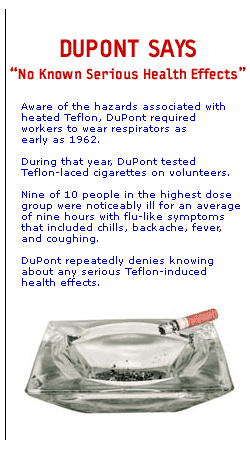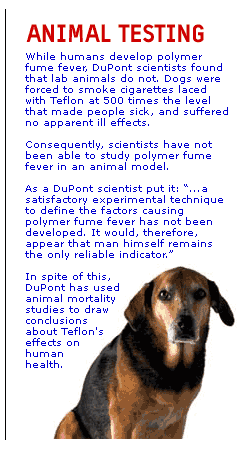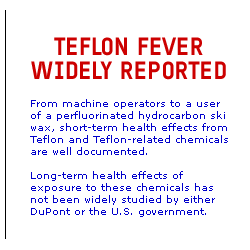
DuPont Recruited “Volunteers”
to Smoke Teflon-Laced Cigarettes
Human Experiment Found that Fumes from
Heated Teflon Make People Sick
As the federal government intensifies its review of a toxic Teflon-related chemical that widely contaminates human blood, researchers are raising questions about the scientific basis for DuPont’s assertion that the brand-name product is itself safe in normal use, a claim the company has offered to the public and the media repeatedly over the past year.
An Environmental Working Group (EWG) review of a series of studies published beginning in the 1950s shows that DuPont has known for at least 50 years that Teflon fumes at relatively low temperatures can cause an acute illness known as polymer fume fever. In several studies DuPont recruited human volunteers and intentionally exposed them to Teflon fumes to the point of illness. Although DuPont has not studied the potential long-term health impacts of chronic exposures to Teflon fumes from home cookware, the studies the company has conducted, including their human experiments, contradict their frequent assertions that heated Teflon is known to be safe. The available evidence suggests that normal use of Teflon cookware causes some unknown but significant incidence of polymer fume fever:

DuPont’s human experiments
In 1962, DuPont scientists conducted two controlled experiments on human “volunteers” to study the Teflon-related illness called polymer fume fever, or simply “the shakes.” The company laced cigarettes with Teflon and had the volunteers inhale the fumes to the point of illness.
In DuPont’s first cigarette experiment, each of up to 40 volunteers in four dosing groups smoked a cigarette laced with between 0.05 and 0.4 milligrams of Teflon. Nine of 10 people in the highest dose group were noticeably ill for an average of nine hours with flu-like symptoms that included chills, backache, fever, and coughing.
DuPont then designed a second experiment to learn how many cigarettes a single worker would need to smoke, each laced with a lower dose of Teflon, to elicit the same illness. Company scientists found that by smoking approximately the same total dose of Teflon over six to 10 cigarettes, study volunteers developed polymer fume fever.
DuPont scientists speculated that smokers are more susceptible to polymer fume fever than other workers because small particles of Teflon from the worker’s fingers can decompose in a burning cigarette. Company scientists found that smoking a cigarette laced with a spec of Teflon about the size of the head of a pin (one millimeter) was equivalent to breathing Teflon fumes at high concentrations for a full workday, or 0.4 milligrams per cubic meter of air over eight hours exposure. This exceeds the exposure levels that caused polymer fume fever in DuPont’s own human experiments.
Teflon produces at least 15 toxins when burned, including carcinogens, chemical warfare agents, and close relatives of highly toxic pesticides. In 1977, the National Institute for Occupational Safety and Health (NIOSH) set workplace standards to protect smokers from polymer fume fever, banning smoking for all workers who come in contact with Teflon in the workplace.
Despite these findings, neither DuPont nor the government has studied the safety of smoking in the home while using standard non-stick cookware that bears a Teflon coating that any cook knows degrades and breaks apart with age. Neither has the prevalence of polymer fume fever from the use of home cookware been studied, although cases are reported in the peer-reviewed literature.
“Kitchen toxicology”
DuPont scientists coined the term “kitchen toxicology” in the 1960s to characterize their limited efforts to learn if the Teflon chemicals that cause polymer fume fever in the workplace were safe for use on cookware in the home. DuPont’s J. Wesley Clayton, Jr. describes the “culmination” of these kitchen experiments as a test in which 12 rats, 10 mice, six guinea pigs, four rabbits, and one dog were exposed to Teflon fumes for six hours and did not die. Clayton concluded that the animal studies demonstrate the “low-life hazard” of using the cookware [Clayton 1967].
Absence of death after short-term exposure is a crude indicator of safety. In contemporary toxicology, scientists are interested in learning much more than the amount of a chemical that immediately kills the test subjects. Even as Teflon was being approved by the Food and Drug Administration (FDA) as a food contact substance, DuPont scientists emphasized that heated Teflon poses a “low life hazard”, lacking studies to address potential long-term health impacts: “To the best of our knowledge, no one has even been killed by exposure to the thermal decomposition or combustion products of the Teflon resins” [Zapp 1962].
DuPont’s Clayton also observed that humans differ from animals in their response to Teflon fumes. While humans develop polymer fume fever, Clayton and others found that lab animals do not. Consequently, scientists have not been able to study polymer fume fever in an animal model. DuPont’s Dr. John Zapp wrote in 1962 that: “We have obliged a dog to smoke repeatedly through a face mask cigarettes containing up to 200 mg of Teflon. It produced neither the polymer fume fever nor any other observable harmful effect.”

“Man himself remains the only reliable indicator”
Humans develop polymer fume fever at an exposure of 0.4 milligrams, 500 times less than the amount that had no effects in dogs. This finding from DuPont raises more questions about the safety of Teflon than it answers, and suggests that humans may be hundreds of times more sensitive than animals to a range of toxic Teflon byproducts.
As DuPont’s Clayton put it: “At the moment a satisfactory experimental technique to define the factors causing polymer fume fever has not been developed. It would, therefore, appear that man himself remains the only reliable indicator.” DuPont has no ongoing study of the health of the hundreds of millions of people who are routinely exposed to fumes from non-stick cookware in the home.
Breathing Teflon tape fumes
The reliability of humans as indicators of Teflon toxicity was confirmed in a mass poisoning incident involving inhalation of Teflon fumes from heated Teflon tape.
One year after DuPont’s cigarette experiments, the Air Force conducted human studies following a C54 flight in which all the passengers and crew became mysteriously ill [Nuttall et al. 1964]. The incident is recounted in a review of fluoropolymer safety conducted 13 years later by the National Institute for Occupational Safety and Health (NIOSH): “Within 1 hour of takeoff, most of the passengers and two of the crew members had chest discomfort and general malaise, including chills, nausea, and respiratory distress in some. One passenger vomited and collapsed and was found 5-10 minutes later in a cyanotic state with a weak and rapid pulse. A second passenger had severe respiratory distress and moderate collapse. Six passengers were incapacitated, and five were given oxygen... On arrival, three passengers required hospitalization, and everyone aboard the plane except one co-pilot had experienced effects, which persisted after the plane landed.” Four people who collected air samples from the plane after it landed also developed a fever reaction [NIOSH 1977].
A series of human experiments was designed to pinpoint the cause. Up to 28 volunteers in six separate trials were exposed to fumes from the exhaust system of the airplane. After ruling out multiple gases and other potential causes, the toxicity was linked to Teflon tape that had covered part of the exhaust manifold, and that had heated up during flight to offgasing temperatures.
Numerous Reports of Polymer Fume Fever
Permanent Lung Damage
Researchers at the Harvard School of Public Health report on a case in which a carding machine operator in a fabric plant experienced progressive deterioration of the lungs after multiple episodes of what the scientists deduced was PTFE-induced polymer fume fever [Kales and Christiani 1994]. He left the plant on disability. They write that the case provides further evidence that polymer fume fever can provide lasting damage, especially among those who suffer multiple episodes or have an underlying pulmonary disease.

In a case of home cookware poisoning in 1993, a previously healthy 26-year-old woman went to the hospital complaining of difficult breathing, chest tightness and cough after being exposed to toxic fumes coming from a defective microwave oven part: a melted and scorched Teflon block used as an axle for a rotating platform in the oven. At the hospital, doctors noted that her heart was racing, and she had high blood pressure, increased white blood cell count (leukocytosis) and was breathing heavily. An X-ray showed she had “diffuse pulmonary infiltrate.” Her lung function was still abnormal a month later, again indicating that Teflon fumes can produce lasting lung damage [Zanen 1993].
Researchers at the Centers for Disease Control and Prevention (CDC) describe why smokers are at higher risk than nonsmokers for the harmful effects of Teflon fumes: “Fluorocarbons may be deposited on cigarettes from the air or from workers’ fingers. As a cigarette is smoked, fluorocarbons are then burned or “pyrolyzed,” and the products of decomposition are inhaled with the cigarette smoke. The actual products of decomposition may vary and are dependent on which polymers were used and at what temperature and humidity they were burned. The most common known products of pyrolysis include inorganic fluoride, hydrogen fluoride, carbonyl fluoride, and perfluoropropane” [CDC 1987].
Smokers can be exposed to higher levels of Teflon fumes, and they also may be more susceptible to harm from Teflon fumes, since many smokers have diminished lung function stemming from their chronic exposures to tobacco smoke. Children with asthma may also be more susceptible to lung damage from Teflon fumes. The extent to which fumes from Teflon cookware contribute to or exacerbate childhood asthma begs study.
Polymer fume fever continues to occur
In two studies of fluoropolymer worker health conducted in 1963 and 1974, more than three-fourths of the workers surveyed reported having experienced polymer fume fever at least once. In the 1974 study, 14 percent of the workers reported succumbing to the illness more than three times in the year preceding the survey. Although not infectious, the fever in these decades had reached the equivalent of epidemic proportions and must have hampered workplace productivity, considering the scope of the symptoms DuPont describes from its survey of complaints registered by workers struck by the illness: tightness of chest, malaise, shortness of breath, headache, cough, chills, temperatures between 100 and 104 °F, and sore throat.
A DuPont scientist reported that workers themselves first deduced how to avoid the illness prior to controls instituted by the government in 1977: “Workers carrying the hot sintered [Teflon] shapes from the ovens to cooling benches found that if they carried them close to their chest, they developed a condition which came to be known as the “shakes”... If they carried them at arm’s length, they developed no symptoms.” [Waritz 1975] But workers who smoked continued to develop the fever even when they carried the hot Teflon at arms length, and so DuPont scientists conducted human experiments with Teflon-laced cigarettes to find if they could elicit the same response in a controlled setting.
Although presumably rates of polymer fume fever have declined since these early reports, workers continue to be plagued with the illness, and the fever can include potentially life-threatening complications. Among the reports of polymer fume fever in the literature are the following cases:
- A previously healthy 21-year-old plastics machinist developed polymer fume fever after smoking for two hours within two hours of leaving work. He developed severe chest tightness, difficulty breathing, fever, nausea, vomiting, and a dry irritating cough. He was diagnosed with polymer fume fever, stemming from exposures to micronized PTFE decomposed through his cigarette [Silver and Young, 1993].
- Norwegian researchers report a case in which a man developed polymer fume fever and pulmonary edema after smoking cigarettes contaminated with perfluorinated hydrocarbon ski wax. The authors warn that inhalation of vapor from ski waxes melted at low temperatures may be harmful to the lungs [Strom and Alexandersen 1990].
- A worker grinding a Teflon-coated surface developed polymer fume fever. He not only developed pulmonary edema, but also previously unreported pericarditis [Haugtomt and Haerem 1989].
- Thirteen soldiers became ill with polymer fume fever after exposure to fumes from a tent oven painted with a coating containing fluorocarbons [Ellingsen 1998].
- A pipe fitter developed polymer fume fever when he rolled his own cigarettes after using PTFE tape. Until this case it was generally thought that the use of Teflon tape was safe, even among smokers [Cooper and Gazzi 1994].
- A carding machine operator in a fabric plant experienced progressive deterioration of the lungs after multiple episodes of what the scientists believe was PTFE-induced polymer fume fever and left the plant on disability [Kales and Christiani 1994].
- Three of five workers at a Mississippi plant that manufactured plastic signs and rubber and metal stamps developed several episodes of polymer fume fever over nine months which, after an extensive NIOSH investigation of many chemicals used in plant processes, were ultimately linked to the workers’ periodic exposures to PTFE in a mold-release spray heated to 305 °F (152 °C). All three employees smoked in the vicinity of the oven. Researchers at the Centers for Disease Control and Prevention reported that the symptoms of one man included lower backache, intense rigors, night fever, chills, malaise, and coughing [CDC 1987].
DuPont health assurances about Teflon
|
Quotation |
Stated By |
Article |
Date |
|
"We know of no adverse conditions or long-term affects associated with polymer fume fever, and if that were the case, we would have known about it and would have reported it," |
Clif Webb, Director of Media Relations for DuPont |
“U.S. Urged to Put Warning Labels on Teflon Pans” |
05/15/03 |
|
“DuPont knows of no record of serious, chronic or acute health problems related to the use of non-stick cookware.” |
Unnamed DuPont Spokesperson |
“Fumes from heated Teflon kill birds, sicken humans: Environmentalists want warning label |
05/15/03 |
|
“[Teflon cookware] is totally safe for consumer use and commercial use." |
Clif Webb, Director of Media Relations for DuPont |
“Environmental group warns of the danger of Teflon cookware” |
05/15/03 |
|
Officials for DuPont, which makes Teflon, claim the non-stick cookware is safe, if used correctly: "We try to make sure consumers understand proper use. But, how each manufacturer conveys information to the consumer is up to them." |
Clif Webb, Director of Media Relations for DuPont |
“Environmental group lobbies for warnings on Teflon cookware” |
05/17/03 |
|
"Extensive scientific research and testing supports the conclusion that DuPont Stainmaster and Teflon branded products are safe for consumers." |
Irvin Lipp of DuPont's public affairs office in Wilmington, Delaware |
“"Group Says C8 Use Should Stop"” |
04/9/03 |
DuPont health assurances about Teflon-related chemicals
|
Quotation |
Stated By |
Article |
Date |
|
"The data overwhelmingly indicate there are no adverse health effects" |
Robert W. Rickard, chief toxicologist for DuPont |
“Toxic Substances Health Risks Warrant Ban of Chemical” |
04/01/03 |
|
DuPont's Rickard told BNA, "Based on over 50 years of experience, an extensive database in laboratory animals, and human surveillance there are no known adverse health effects associated with C-8." |
Robert W. Rickard, chief toxicologist for DuPont |
“Toxic Substances Health Risks Warrant Ban of Chemical” |
04/01/03 |
|
“[C8] has been used safely for more than 50 years with no known adverse effects to human health.” |
DuPont vice president Richard J. Angiullo |
“Concerns Grow About Risk from DuPont Chemical C8” |
04/04/03 |
|
“PFOA has been wrongfully represented as a health risk when, in fact, it has been used safely for more than 50 years with no known adverse effects to human health.” |
Second Anonymous DuPont Official |
“Seeking Product Bans: Environmentalists Push EPA Study on Chemicals in Consumer Goods” |
04/04/03 |
|
There are two facts about C8 that I cannot emphasize enough. The first point is that DuPont and other companies have worked with C8 for more than 50 years, and we know of no adverse human health effects related to this material. This is based not only on extensive publicly available scientific data, but also on data from our industrial hygiene program for own employees. The second point is that DuPont would never knowingly put the people in the communities in which we operate in harm's way. |
Paul J. Bossert, Jr. |
www.c8inform.com |
03/18/03 |
|
“Clearly, the document has not been subject to full EPA review. There are many studies on the toxicity of PFOA leading us and others to conclude that the compound is safe for all segments of the population, including women of child-bearing age and young girls.” |
Richard Angiullo, vice president and general manager of DuPont |
“Environmental Group is Calling for Ban of PFOA” |
04/07/03 |
|
"DuPont remains confident that our use of PFOA over the past 50 years has not posed a risk to either human health or the environment and that our products are safe,'' Angiullo said. "Our confidence is based on an extensive scientific database.'' |
Richard Angiullo, vice president and general manager for DuPont |
“EPA to Investigate Chemical Found in many Household Items” |
04/14/03 |




